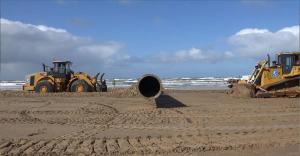Usually in April, dredging vessels bring a total of 400,000 cubic meters of sand to Egmond aan Zee beach between boat club de Werf to just past beach pavilion De Tropen. The equipment then goes over the beach to Bergen aan Zee. There, 600,000 cubic yards of sand will be applied to the beach from the Bergen Coastal Sailing and Boating Association to just past pavilion Uit de Kunst. All work is scheduled to be completed by the end of April. The equipment will then be removed via the beach back at Egmond aan Zee.
 Why this coastal reinforcement?
Why this coastal reinforcement?
Wind and sea cause the coast at Bergen and Egmond aan Zee to lose sand. To ensure that Bergen and Egmond aan Zee remain well protected from the sea, Rijkswaterstaat is bringing sand to the beach. This will temporarily widen the beach again. Nature, tourism and recreation also benefit. To strengthen the coast even further, two million cubic meters of sand will also be placed underwater just offshore later this year or next.
Coastal maintains
The work at Bergen and Egmond aan Zee is part of Rijkswaterstaat’s coastal maintenance program. Together with the water boards, Rijkswaterstaat maintains the Dutch coast. If we do not, we will lose much of our land to the sea. And that very part is where many people live and many businesses are located. By spraying sand on and just offshore, the Department of Public Works keeps the coastline in place. This keeps the Netherlands well protected from the sea.
Good to know.
Due to the work, the beach is not accessible everywhere in April and May. The work site is off limits due to danger of quicksand and bulldozers driving around. The work area is about 250 meters long and shifts with the work.On and near reclaimed beaches, sand can drift more than normal in high winds. This is not pleasant for beachgoers, but it is necessary for nature in the dune area. Moreover, this way our flood barrier grows naturally and rises with sea level.
Beach visitors are, of course, still welcome outside the work area and it is also highly recommended to come and take a look. The dredging shovels, bulldozers and immense loads of sand produce beautiful pictures.
Sea
During the work, one or more dredging vessels are off the coast spraying or dumping sand. Surfers, sailors and skippers of other vessels should take this into account and sail around it at a safe distance. With notices to mariners, we inform boaters of the work. Information signs are posted at beach entrances to inform water sports enthusiasts.

